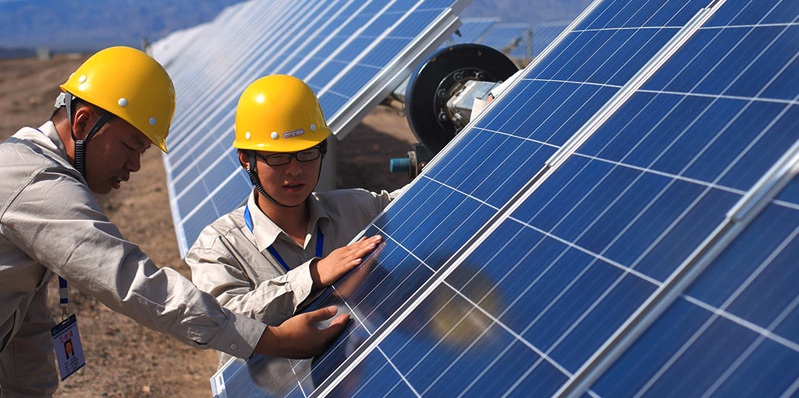Some Chinese power plant developers have negotiated with grid operators or the government to postpone PV power plant project grid-connection deadlines through to late July. Thus the current installation boom will carry through until July. This connection deadline extension has led to continued robust demand in China in the short term.
Meanwhile, Europe is entering the traditional peak-selling season and the “Section 201” trade case, instigated by Suniva, has resulted in installation boom ahead of expected schedule in the U.S. Therefore, developers in China, Europe, and the U.S. find themselves placing module orders at the same time. Unlike all sectors of the supply chain, which witnessed plummeting prices last July, demand will be high this July. Supported by European and U.S. demand in 3Q17, prices won’t decline as dramatically as they did in 2016.
However, strong Chinese demand is drawing to a close. Although orders have mostly been confirmed for early July, mid-to-upstream sectors are not confident they will be able to maintain current prices come late July.
 Commencing at the end of this month, there will be two different situations in the Chinese and non-Chinese markets:
Commencing at the end of this month, there will be two different situations in the Chinese and non-Chinese markets:
Because Chinese modules to the U.S. can attract high tariffs, it is difficult for Chinese producers to ship to the most significant market. Likewise, for E.U. markets, Chinese suppliers are limited by the high minimum import price (MIP). Because of this, local Chinese manufacturers will have to rely on the following demand drivers for utility-scale installations in July:
China:
1) The “Top Runner Program” that requires the completion of grid-connection before September 30 – mostly high-efficiency mono-Si module demand.
2) Local distributed generation (DG) projects – despite growth this year, demand is small compare to utility-scale power plant projects.
3) Overseas markets outside of Europe and the U.S. – namely India, Japan, Australia, and other emerging markets.
Popular content
Since Chinese demand has dropped significantly and India is entering the rainy season, which leads to a slight decline in demand in 3Q17, Chinese capacity will once again face an oversupply situation. As a result, supply chain prices may start to decline in late July or August.
Outside of China:
Europe is entering the traditional peak-selling season in Q3 and SolarWorld has created a supply vacancy due to its bankruptcy. Because of this, high-efficiency module demand will stem from the E.U. Meanwhile, an installation boom in the U.S. has appeared, before expected trade barriers resulting from the “Section 201” action, are officially put into practice. Many U.S. PV power plants are being constructed ahead of time, leading to strong demand and high order visibility for the manufacturers that are not applicable to the trade barriers set by Europe and the U.S. The previously lower ASPs (average selling prices) has increased substantially in the U.S. market.
Orders for July and August have been confirmed for European, U.S., Southeast Asian, and Korean manufacturers. High-efficiency mono-Si modules are even in short supply in Europe and the U.S., resulting in higher prices.
For cells, prices have increased rapidly in third-party countries – those outside of China. Prices for conventional multi-Si cells with an efficiency of 18.4% have gone up to US$0.24 – 0.25/W. Although Taiwanese cells shipped to the U.S. have been restricted by the anti-dumping duties, prices are slightly higher than Chinese cells in July, as Taiwanese cells do not face trade barriers when shipping to Europe. At the same time, owing to the strong demand of mono-Si PERC cells, prices have stayed flat, unlike the decline of mono-Si wafer prices.
Looking ahead, no matter how the “Section 201” will be settled, it’s foreseeable that the supply chain prices in Q3 will be higher than anticipated. On the other hand, as the European and U.S. markets face module shortages, the price gap between these two markets and other regions will widen further.
This content is protected by copyright and may not be reused. If you want to cooperate with us and would like to reuse some of our content, please contact: editors@pv-magazine.com.



3 comments
By submitting this form you agree to pv magazine using your data for the purposes of publishing your comment.
Your personal data will only be disclosed or otherwise transmitted to third parties for the purposes of spam filtering or if this is necessary for technical maintenance of the website. Any other transfer to third parties will not take place unless this is justified on the basis of applicable data protection regulations or if pv magazine is legally obliged to do so.
You may revoke this consent at any time with effect for the future, in which case your personal data will be deleted immediately. Otherwise, your data will be deleted if pv magazine has processed your request or the purpose of data storage is fulfilled.
Further information on data privacy can be found in our Data Protection Policy.